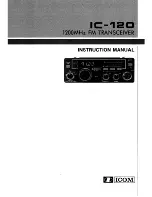
viii
Precautions about SpO
2
W A R N I N G
During SpO
2
monitoring, always use the probe (sensor) specified by
Fukuda Denshi. If any other probe (sensor) is used, a high temperature
rise of the probe (sensor) may place the patient in danger of burns in
the worst case.
When the SpO
2
probe (sensor) is in a connector-off condition, the SpO
2
alarm will not be generated on the receiving monitor. Make sure that the
SpO
2
probe (sensor) is securely connected. If the SpO
2
waveform/numeric data is not displayed, check the patient’s condition
and pay attention not to miss the connector-off condition.
When measuring the SpO
2
of a patient with high fever or peripheral
circulatory insufficiency, check the probe (sensor) attachment
periodically and change the attachment site. The temperature of the
attachment site will rise 2 to 3 C due to the sensor heat which may
result in compression necrosis and burn injury.
Even a short duration of attachment may inhibit the blood flow and
generate compression necrosis and burn injury.
When securing the probe (sensor) with tape, do not apply the tape too
tight. At the same time, check the blood flow constantly so that
congestion is not generated at the peripheral. When removing the tape,
remove it slowly with care not to damage the patient’s skin.
C A U T I O N
For the following case, accurate measurement may not be possible.
Patient with excessive abnormal hemoglobin (COHb, MetHb)
Patient with the pigment injected to the blood
Patient receiving CPR treatment
Placement of SpO
2
probe (sensor) on limb with a blood-pressure cuff,
arterial catheter, or intravascular line
When measuring at placement position with venous pulse
Patient with body motion
Patient with small pulse
Excessive body motion (patient’s motion)
Excessive light (direct sunlight, fluorescent, light therapy equipment,
surgical light, infrared heat ramp, etc.)
External colorant such as nail polish
Abnormally low or high hemoglobin concentration
Electrosurgery
Influence of electromagnetic waves from other electronics devices
High-intensity radio waves from mobile phones
Summary of Contents for LX-7230N
Page 22: ...1 General Description 2 Blank Page ...
Page 28: ...3 Preparation 8 Blank Page ...
Page 36: ...5 Respiration Monitoring 16 Blank Page ...
Page 66: ...7 Measurement 46 Blank Page ...
Page 72: ...8 Operation 52 Blank Page ...
Page 78: ...10 Changing the Transmitter Channel and Group ID 58 Blank Page ...
Page 84: ...11 Troubleshooting 64 Blank Page ...
Page 92: ...14 Standard and Optional Accessories 72 Blank Page ...











































